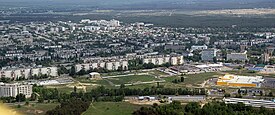Sievierodonetsk
Severodonetsk | |
|---|---|
City | |
From top to bottom and left to right: City's Center Market; Sievierodonetsk Collegium; City council building; Azot Chemical Plant; Palace of Culture of Chemists; Prospect of Sievierodonetsk from above | |
| Coordinates: 48°56′53″N 38°29′36″E / 48.94806°N 38.49333°E | |
| Country | |
| Oblast | Luhansk Oblast |
| Raion | Sievierodonetsk Raion |
| Hromada | Sievierodonetsk urban hromada |
| Founded | 29 April 1934 |
| City status | 1958 |
| Government | |
| • Head of Military-Civil Administration | Oleksandr Stryuk |
| Area | |
• Total | 42.1 km2 (16.3 sq mi) |
| Elevation | 51 m (167 ft) |
| Population (2022) | |
• Total | 99,067 |
| • Density | 2,400/km2 (6,100/sq mi) |
| Time zone | UTC+2 (EET) |
| • Summer (DST) | UTC+3 (EEST) |
| Postal code | 93400 |
| Area code | +380 6452 (645) |
| Vehicle registration | BB, HB |
| Climate | Dfb |
| Website | sed-rada.gov.ua |
 | |
Sievierodonetsk[a] (UK: /ˌsɛvərədɒnˈjɛtsk/ SEV-ər-ə-don-YETSK), also spelled Severodonetsk[b] or Siverskodonetsk,[c] is a city in Luhansk Oblast, eastern Ukraine. It is located to the northeast of the left bank of the Donets river and approximately 110 km (68 mi) to the northwest from the administrative center of the oblast, Luhansk. Sievierodonetsk faces neighbouring Lysychansk across the river. The city, whose name comes from the above-mentioned river, had a population of 99,067 (2022 estimate),[1] making it then the second-most populous city in the oblast. Since June 2022, it has been militarily occupied and administered by Russia.[2][3]
Prior to the war, Sievierodonetsk had several factories as well as the Azot chemical plant. There was also an airport six kilometres (3.7 mi) to the south of the city.[4]
Sievierodonetsk served as the administrative centre of Luhansk Oblast from 2014 to 2022, due to the city of Luhansk falling under the control of pro-Russian separatists at the start of the war in Donbas.[5][6] During the Russian invasion of Ukraine, Sievierodonetsk came under heavy attack from Russian forces and was the forefront of the battle of Donbas,[7] resulting in extensive destruction to the city, including residential areas.[8] By 25 June 2022, the city was fully captured by Russian and separatist forces,[9] with Ukrainian authorities claiming that the civilian population was approximately 10,000, or ten percent of its pre-war population.[10]
Cite error: There are <ref group=lower-alpha> tags or {{efn}} templates on this page, but the references will not show without a {{reflist|group=lower-alpha}} template or {{notelist}} template (see the help page).
- ^ Чисельність наявного населення України на 1 січня 2022 [Number of Present Population of Ukraine, as of January 1, 2022] (PDF) (in Ukrainian and English). Kyiv: State Statistics Service of Ukraine. Archived (PDF) from the original on 4 July 2022.
- ^ "Russian, LPR forces liberate Severodonetsk - Russian top brass - Military & Defense - TASS". tass.com. Retrieved 2022-06-26.
- ^ "Ukrainian forces withdrawing from key city in Donbas mostly under Russian control". 2022-01-06. Retrieved 2023-01-05.
- ^ Sievierodonetsk Airport (UKCS | SEV) at Great Circle Mapper
- ^ "Kikhtenko to move Donetsk administration to Kramatorsk and to leave power structures in Mariupol". Dzerkalo Tyzhnia media.
- ^ "In Severodonetsk, Petro Poroshenko presented Luhansk RSA Head Hennadiy Moskal". President of Ukraine, official website. Archived from the original on 2015-03-18.
- ^ Ponomarenko, Illia (7 May 2022). "Russia's offensive in Donbas bogs down". The Kyiv Independent. Retrieved 13 May 2022.
- ^ "Satellite images show scale of destruction in Ukrainian industrial city of Sievierodonetsk", ABC Net, 8 June 2022
- ^ "Ukrainian city of Severodonetsk now 'completely under Russian occupation' after months of fighting". CNN. 25 June 2022.
- ^ Ponomarenko, Illia (30 June 2022). "As Ukraine withdraws from Sievierodonetsk, Battle of Donbas enters next phase". Kyiv Independent. Retrieved 2 July 2022.









